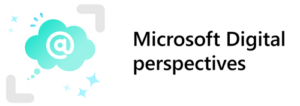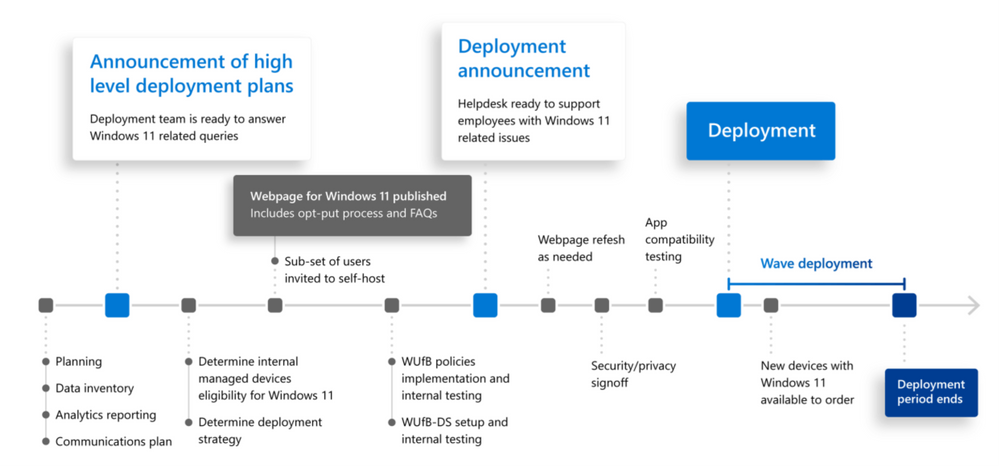
[Editor’s note: This content was written to highlight a particular event or moment in time. Although that moment has passed, we’re republishing it here so you can see what our thinking and experience was like at the time.]
Microsoft’s upgrade to Windows 11 was the smoothest in company history. The Microsoft Digital team was able to upgrade 190,000 employee devices in just five weeks. And we learned a lot! Here are our key learnings to help with your own deployment journey.
Why did we succeed?
- Fewer app compatibility challenges
- No need for complex disk images
- Delivery processes and tools that were already optimized during the rollout of Windows 10.
We divided our upgrade into three stages: plan, prepare, and deploy.

- Insights you can use: Microsoft’s internal upgrade to Windows 11 (this blog post)
- Microsoft tries Windows 11 on for size and likes the fit
- Unpacking Microsoft’s speedy upgrade to Windows 11
- Windows 11 boosts employee engagement at Microsoft
- Employees are at the heart of Microsoft’s internal Windows 11 upgrade
- Five key learnings from Microsoft’s Windows 11 upgrade
Start with a good plan
First, we determined which devices could be upgraded. Windows 11 has specific hardware requirements, and not all devices were eligible to be upgraded. Employees with these devices will continue to run Windows 10—when their current PC is ready for an upgrade, they’ll get a device that runs Windows 11. We used Update Compliance and Microsoft Endpoint Manager’s Endpoint analytics feature to evaluate our device population. In total, 190,000 devices qualified for the upgrade, and 99 percent of upgrades were successful.
Knowing which devices were upgradable enabled us to create a clear timeline, helping our communications team to land the upgrade with our employees. We used a ring-based approach to manage the upgrade, which allowed us to gradually release Windows 11 across the company.
Prepare readiness content
Past upgrades didn’t always go smoothly—system crashes, blue screens, incompatible hardware all led to communications challenges as we tried to mitigate upgrade issues. But with Windows 11, knowing that upgrades were mostly smooth, we were able to focus our communications on building excitement. The goal? Make readiness content easily digestible for everyone. We used Yammer, FAQs, Microsoft SharePoint, email, Microsoft Teams, our internal homepage, and digital signage to reach employees. We drove interest by focusing on Windows’ new look and feel, exciting new features, and by assuring users that the upgrade would be fast—and completed on their schedule.
Employees who were eager to upgrade were encouraged to use the PC Health Check app to test if their device qualified.
While our Support team didn’t get many tickets related to the upgrade process, they were still prepared—they were some of the first users of Windows 11 at Microsoft.
Test and measure
We used Microsoft Power BI to measure our success against our upgrade goals and to identify learnings along the way. We tracked the number of devices that we needed to upgrade by country and region, by eligibility, and by adoption. This allowed us to identify and communicate with those who didn’t qualify for an update.
Deploying Windows 11
We used Windows Update for Business deployment service to automate the upgrade. It helped us manage exclusions and opt outs, and, if needed, made it easy to rollback a device to Windows 10.
Our success hinged on setting up the right policies ahead of time. This allowed us to do things like:
- Minimize how many alerts an employee would receive before their device was upgraded.
- Reduce the number policies that the deployment team needed to manage during the upgrade.

Help from Windows Autopilot
We used Windows Autopilot to make sure all new devices come preloaded with Windows 11—a new device only needs to be turned on for Windows Autopilot to kick in and configure everything for the employee.
Succeeding with Windows 11
The upgrade to Windows 11 was a huge success. We had no increase in support tickets, we had broad adoption across the company, and it was the fastest operating system deployment in company history. We hope that sharing our story helps you tackle your Windows 11 upgrade.

- The disruption-free deployment of Windows 11 was powered by the same tools and practices Microsoft Digital used for Windows 10.
- Since Windows 10 and Windows 11 can be managed side-by-side, employees will use their current devices until it’s time for a refresh.
- Apps that work on Windows 10 work on Windows 11. An improved user interface improves employee productivity.
- As customer zero, Microsoft employees take on the role of providing feedback and suggesting improvements from an enterprise perspective. Listen to your own employees throughout the upgrade process to ensure your upgrade is as successful as ours!

- To learn about the business value of upgrading to Windows 11, read Microsoft tries Windows 11 on for size and likes the fit.
- To go deeper, read our technical case study: Unpacking Microsoft’s speedy upgrade to Windows 11.
- Want more information about our internal upgrade? Check out Moving Microsoft to Windows 11.
- Discover valuable insights you can use: Looking back at deployment of Windows 11 at Microsoft.




